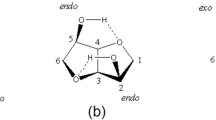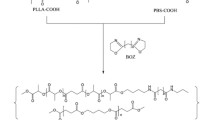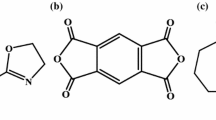Abstract
Novel biodegradable poly(ester amide)s (PEAs) based on l-lactic acid (l-LA) oligomers and glycine were successfully synthesized, through an easy and fast procedure, making use of inexpensive starting materials. The l-LA oligomers were prepared with different central units and different molecular weights in order to access the influence of such parameters in the final properties of the PEAs’. Both the central unit of the l-LA oligomer and its molecular weight have important influence in the PEAs’ final properties. The thermal stability is lower for the PEAs containing the l-LA with the shortest central unit and for the PEAs based on the l-LA oligomers of high molecular weight. The PEAs exhibit a semi-crystalline nature, except those derived from the l-LA oligomers with high molecular weight, which have an amorphous character. Both hydrolytic and enzymatic degradation are more pronounced in PEAs synthesized from the l-LA oligomers with low molecular weight. Different mechanisms of degradation were found for the PEAs: bulk erosion and surface erosion, for hydrolytic degradation and enzymatic degradation tests, respectively.












Similar content being viewed by others
References
Rodriguez-Galan A, Franco L, Puiggali J (2010) Degradable poly(ester amide)s for biomedical applications. Polymers 3(1):65–99
Luckachan GE, Pillai CKS (2006) Random multiblock poly(ester amide)s containing poly (l-lactide) and cycloaliphatic amide segments: synthesis and biodegradation studies. J Polym Sci, Part A: Polym Chem 44(10):3250–3260
Deshayes G, Delcourt C, Verbruggen I, Trouillet-Fonti L, Touraud F, Fleury E, Degee P, Destarac M, Willem R, Dubois P (2011) Novel polyesteramide-based di- and triblock copolymers: from thermo-mechanical properties to hydrolytic degradation. Eur Polym J 47(1):98–110
Khan W, Muthupandian S, Farah S, Kumar N, Domb AJ (2011) Biodegradable polymers derived from amino acids. Macromol Biosci 11(12):1625–1636
Sun H, Meng F, Dias AA, Hendriks M, Feijen J, Zhong Z (2011) alpha-Amino acid containing degradable polymers as functional biomaterials: rational design, synthetic pathway, and biomedical applications. Biomacromolecules 12(6):1937–1955
Feng Y, Lu J, Behl M, Lendlein A (2010) Progress in depsipeptide-based biomaterials. Macromol Biosci 10(9):1008–1021
Feng YK, Guo JT (2009) Biodegradable polydepsipeptides. Int J Mol Sci 10(2):589–615
Dijkstra PJ, Feijen J (2000) Synthetic pathways to polydepsipeptides. Macromol Symp 153:67–76
Katsarava R, Ochkhikdze N, Tugushi D, Gomurashvili ZD (2010) AABB-Poly(depsipeptide) biodegradable polymers and methods of use US2010/0040664 A1, United States of America Patent
Fonseca AC, Coelho JFJ, Serra AC, Gil MH, Simões PN (2013) Novel poly(ester amide)s from glycine and (l)-lactic acid by an easy and cost effective synthesis methodology. Polym Int 62(5):736–743
D’Angelo S, Galletti P, Maglio G, Malinconico M, Morelli P, Palumbo R, Vignola MC (2001) Segmented poly(ether-ester-amide)s based on poly(L, l-lactide) macromers. Polymer 42(8):3383–3392
De Simone V, Maglio G, Palumbo R, Scardi V (1992) Synthesis, characterization, and degradation of block polyesteramides containing poly(l-lactide) segments. J Appl Polym Sci 46(10):1813–1820
Fonseca AC, Coelho JFJ, Valente JFA, Correia TR, Correia IJ, Gil MH, Simões PN (2013) Poly(ester amide)s based on (l)-lactic acid oligomers and α-amino acids: influence of the α-amino acid side chain in the poly(ester amide)s properties. J Biomater Sci Polym Ed 24(12):1391–1409
Hiltunen K, Harkonen M, Seppala JV, Vaananen T (1996) Synthesis and characterization of lactic acid based telechelic prepolymers. Macromolecules 29(27):8677–8682
Hiltunen K, Seppala JV (1998) The use of different diols in the synthesis of low-molecular-weight lactic-acid-based telechelic prepolymers. J Appl Polym Sci 67(6):1017–1023
Abreu CMR, Mendonça PV, Serra AC, Coelho JFJ, Popov AV, Gryn’ova G, Coote ML, Guliashvili T (2012) Reversible addition-fragmentation chain transfer polymerization of vinyl chloride. Macromolecules 45(5):2200–2208
Coelho JFJ, Carreira M, Popov AV, Gonçalves PMOF, Gil MH (2006) Thermal and mechanical characterization of poly(vinyl chloride)-b-poly(butyl acrylate)-b-poly(vinyl chloride) obtained by single electron transfer—degenerative chain transfer living radical polymerization in water. Eur Polym J 42(10):2313–2319
Coelho JFJ, Carreira M, Popov AV, Gonçalves PMOF, Gil MH (2006) Processability and characterization of poly(vinyl chloride)-b-poly(n-butyl acrylate)-b-poly(vinyl chloride) prepared by living radical polymerization of vinyl chloride. Comparison with a flexible commercial resin formulation prepared with PVC and dioctyl phthalate. J Vinyl Addit Technol 12(4):156–169
Coelho JFJ, Carvalho EY, Marques DS, Popov AV, Gonçalves PMOF, Gil MH (2007) Synthesis of poly(lauryl acrylate) by single-electron transfer/degenerative chain transfer living radical polymerization catalyzed by Na2S2O4 in water. Macromol Chem Phys 208(11):1218–1227
Coelho JFJ, Carvalho EY, Marques DS, Popov AV, Percec V, Gonçalves PMOF, Gil MH (2008) Synthesis of poly(ethyl acrylate) by single electron transfer-degenerative chain transfer living radical polymerization in water catalyzed by Na2S2O4. J Polym Sci, Part A: Polym Chem 46(2):421–432
Paredes N, Rodríguez-Galán A, Puiggalí J (1998) Synthesis and characterization of a family of biodegradable poly(ester amide)s derived from glycine. J Polym Sci, Part A: Polym Chem 36(8):1271–1282
Albertsson A-C, Varma IK (2003) Recent developments in ring opening polymerization of lactones for biomedical applications. Biomacromolecules 4(6):1466–1486
Rashkov I, Manolova N, Li SM, Espartero JL, Vert M (1996) Synthesis, characterization, and hydrolytic degradation of PLA/PEO/PLA triblock copolymers with short poly(l-lactic acid) chains. Macromolecules 29(1):50–56
Malberg S, Plikk P, Finne-Wistrand A, Albertsson A-C (2010) Design of elastomeric homo- and copolymer networks of functional aliphatic polyester for use in biomedical applications. Chem Mater 22(9):3009–3014
Kaczmarczyk B (1998) FTir study of hydrogen bonds in aliphatic polyesteramides. Polymer 39(23):5853–5860
Skrovanek DJ, Howe SE, Painter PC, Coleman MM (1985) Hydrogen-bonding in polymers—Infrared temperature studies of an amorphous polyamide. Macromolecules 18(9):1676–1683
Kaczmarczyk B, Sek D (1995) Hydrogen bonds in poly(ester amide)s and their model compounds. Polymer 36(26):5019–5025
Sudha JD (2000) Synthesis and characterization of hydrogen-bonded thermotropic liquid crystalline aromatic-aliphatic poly(ester-amide)s from amido diol. J Polym Sci, Part A: Polym Chem 38(13):2469–2486
Armelin E, Paracuellos N, Rodriguez-Galan A, Puiggali J (2001) Study on the degradability of poly(ester amide)s derived from the alpha-amino acids glycine, and l-alanine containing a variable amide/ester ratio. Polymer 42(19):7923–7932
Botines E, Franco L, Puiggali J (2006) Thermal stability and degradation studies of alternating poly(ester amide)s derived from glycolic acid and omega-amino acids. J Appl Polym Sci 102(6):5545–5558
Vera M, Admetlla M, Rodríguez-Galán A, Puiggalí J (2005) Synthesis, characterization and degradation studies on the series of sequential poly(ester amide)s derived from glycolic acid, 1,6-hexanediamine and aliphatic dicarboxylic acids. Polym Degrad Stab 89(1):21–32
van Bennekom ACM, Willemsen PAAT, Gaymans RJ (1996) Amide-modified poly(butylene terepthalate): thermal stability. Polymer 37(24):5447–5459
Garg P, Keul H, Klee D, Moeller M (2009) Thermal properties of poly(ester amide)s with isolated, two adjacent and three adjacent amide groups within a polyester chain. Macromol Chem Phys 210(20):1754–1765
Lips PAM, Broos R, van Heeringen MJM, Dijkstra P, Feijen J (2005) Synthesis and characterization of poly(ester amide)s containing crystallizable amide segments. Polymer 46(19):7823–7833
Wang B, Zhang Y, Guo Z, Cheng J, Fang Z (2011) Biodegradable aliphatic/aromatic copoly(ester-ether)s: the effect of poly(ethylene glycol) on physical properties and degradation behavior. J Polym Res 18(2):187–196
Itxaso Calafel M, Remiro PM, Milagros Cortazar M, Elena Calahorra M (2010) Cold crystallization and multiple melting behavior of poly(l-lactide) in homogeneous and in multiphasic epoxy blends. Colloid Polym Sci 288(3):283–296
Sanchez MS, Mathot VBF, Poel GV, Ribelles JLG (2007) Effect of the cooling rate on the nucleation kinetics of poly(l-lactic acid) and its influence on morphology. Macromolecules 40(22):7989–7997
Chromcova D, Baslerova L, Roda J, Brozek J (2008) Polymerization of lactams. 99 Preparation of polyesteramides by the anionic copolymerization of epsilon-caprolactam and epsilon-caprolactone. Eur Polym J 44(6):1733–1742
Shi D, Wang X-Y, Shi H, Yin J-H, Li RKY, Hu G-H (2010) Cold crystallization behavior of polyamide 6 in PS-g-PA6 graft copolymers. J Polym Sci, Part B: Polym Phys 48(1):65–73
Wellen R, Rabello M (2005) The kinetics of isothermal cold crystallization and tensile properties of poly(ethylene terephthalate). J Mater Sci 40(23):6099–6104
Schawe JEK, Höhne GWH (1996) Modulated temperature DSC measurements relating to the cold crystallization process of poly(ethylene terephtalate). J Therm Anal Calorim 46(3):893–903
Pang X, Chu C-C (2010) Synthesis, characterization and biodegradation of functionalized amino acid-based poly(ester amide)s. Biomaterials 31(14):3745–3754
Knight DK, Gillies ER, Mequanint K (2011) Strategies in functional poly(ester amide) syntheses to study human coronary artery smooth muscle cell interactions. Biomacromolecules 12(7):2475–2487
Guo K, Chu CC, Chkhaidze E, Katsarava R (2005) Synthesis and characterization of novel biodegradable unsaturated poly(ester amide)s. J Polym Sci, Part A: Polym Chem 43(7):1463–1477
Guo K, Chu CC (2007) Synthesis, characterization, and biodegradation of novel poly(ether ester amide)s based on l-phenylalanine and oligoethylene glycol. Biomacromolecules 8(9):2851–2861
Pepic D, Zagar E, Zigon M, Krzan A, Kunaver M, Djonla J (2008) Synthesis and characterization of biodegradable aliphatic copolyesters with poly(ethylene oxide) soft segments. Eur Polym J 44(3):904–917
Bezemer JM, Weme PO, Grijpma DW, Dijkstra PJ, van Blitterswijk CA, Feijen J (2000) Amphiphilic poly(ether ester amide) multiblock copolymers as biodegradable matrices for the controlled release of proteins. J Biomed Mater Res 52(1):8–17
Tsuji H, Yamamoto J (2011) Hydrolytic degradation and thermal properties of linear 1-arm and 2-arm poly(dl-lactic acid)s: effects of coinitiator-induced molecular structural difference. Polym Degrad Stab 96(12):2229–2236
Ruiz-Donaire P, Bou JJ, Muñoz-Guerra S, Rodriguez-Galan A (1995) Hydrolytic degradation of polyamides based on l-tartaric acid and diamines. J Appl Polym Sci 58(1):41–54
Bueno Martínez M, Molina Pinilla I, Zamora Mata F, Galbis Pérez JA (1997) Hydrolytic degradation of poly(ester amides) derived from carbohydrates. Macromolecules 30(11):3197–3203
Asín L, Armelin E, Montané J, Rodriguez-Galán A, Puiggalí J (2001) Sequential poly(ester amide)s based on glycine, diols, and dicarboxylic acids: thermal polyesterification versus interfacial polyamidation. Characterization of polymers containing stiff units. J Polym Sci, Part A: Polym Chem 39(24):4283–4293
Armelin E, Paracuellos N, Rodriguez-Galán A, Puiggali J (2001) Study on the degradability of poly(ester amide)s derived from the α-amino acids glycine, and l-alanine containing a variable amide/ester ratio. Polymer 42(19):7923–7932
Thomas V, Muthu J (2008) Biomechanical studies on aliphatic physically crosslinked poly(urethane urea) for blood contact applications. J Mater Sci—Mater Med 19(7):2721–2733
Wang L, Wang Y, Cao D (2009) Synthesis and characterization of novel biodegradable polyamides containing α-amino acid. J Macromol Sci Part A Pure Appl Chem 46(3):312–320
Acknowledgments
A. C. Fonseca acknowledges “Fundação para a Ciência e Tecnologia”, Grant: SFRH/BD/41305/2007. The 1H NMR data were obtained from Rede Nacional de RMN in the University of Coimbra, Portugal. The Varian VNMRS 600 MHz spectrometer is part of the National NMR Network and was purchased in the framework of the National Program for Scientific Re-equipment (contract REDE/1517/RMN/2005, with funds from POCI 2010 (FEDER) and Fundação para a Ciência e Tecnologia (FCT)).
Author information
Authors and Affiliations
Corresponding author
Electronic supplementary material
Below is the link to the electronic supplementary material.
Rights and permissions
About this article
Cite this article
Fonseca, A.C., Coelho, J.F.J., Gil, M.H. et al. Poly(ester amide)s based on l-lactic acid oligomers and glycine: the role of the central unit of the l-lactic acid oligomers and their molecular weight in the poly(ester amide)s properties. Polym. Bull. 71, 3085–3109 (2014). https://doi.org/10.1007/s00289-014-1239-6
Received:
Revised:
Accepted:
Published:
Issue Date:
DOI: https://doi.org/10.1007/s00289-014-1239-6




